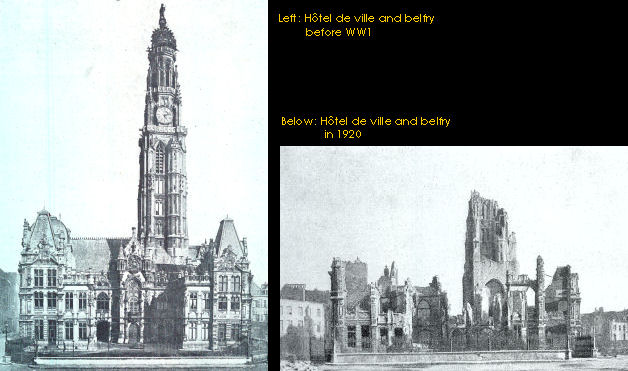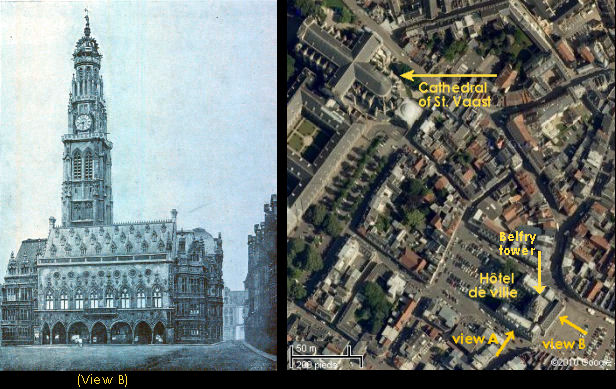







 |
 |
 |
 |
 |
|||
 |
 |
 |
germans in france -arras cathedral |
|
|
|
|
||
|
Gustave
Eiffel’s first work: the Eiffel passerelle, Bordeaux a
dream unfulfilled - the transporter bridge [pont transbordeur],
Bordeaux a
fifth bridge coming to Bordeaux: pont Chaban-Delmas,
a new vertical lift bridge Ile
de France, Paris: in the context of Abelard and of French
cathedrals France’s western isles: Ile de Ré France’s western iles: Ile d’Oleron Marianne - a French national symbol, with French definitive stamps Pic
du Midi - observing stars clearly, A64 Carcassonne,
A61: world heritage fortified city Futuroscope the French umbrella & Aurillac 50
years old: Citroën DS mardi gras! carnival in Basque country what a hair cut! m & french pop/rock country life in France: the poultry fair |
After the Revolution smashed the great cathedral of Arras, a local church, Saint John Baptiste, substituted as Arras cathedral until the vast eyesore of Saint Vaast was ready in 1883. Saint John Baptiste, which had survived the Revolution, ironically renamed as a Temple of the Goddess of Reason, was destroyed by the Germans in 1915. As well as the serving cathedral, Saint John Baptiste was rather crudely rebuilt during the 1920s. Completely destroyed by April 1917, the cathedral was restored in 1920. Further damage during WW2 has also been repaired. Arras cathedral is one of the largest cathedrals at 104 metres long by 26 metres wide, with a 30-metre high nave.
In 1914 was the first battle of Arras, part of an attempt by the French to outflank the Germans making a north-westerly movement towards the English Channel, called the ‘race to the sea’. During the succeeding years of World War One, Arras was subject to more battles as possession of the region changed again and again. “The beautiful original Gothic cathedral of Arras, erected in the 12th and 13th centuries, having been first sold as national property, then pulled down during the Revolution, the church of St. Vaast Abbey became the Mother-Church in the 19th century. “The new cathedral, now entirely in ruins, was a very large building, the erection of which was begun in 1755 from plans by Coutant d'Ivry, the architect who, later, built the Church of La Madeleine in Paris. The work was interrupted during the Revolution, then resumed by virtue of a municipal decree dated “Nivôse 27, Year XII”, which ran: " ... to erect the edifice, abandoning everything in the original plans connected with decoration and architectural beauty, limiting the work to the requirements of solidity and decency.” The church was finished in accordance with these prescriptions, being completed in 1834. The interior was of plaster-coated brickwork, whilst the columns were of undressed stone, covered with stone-coloured mortar. The capitals were of stucco-work.
“Built in the shape of a Latin cross, the Church measured 330 feet in length, 86 feet in width and 106 feet in height. It comprised a great four-bayed nave with side-aisles, a wide double transept, a two-bayed choir, and an apse with ambulatory, off which opened seven chapels. “The main (west) façade has retained its principal lines. In front is a flight of 48 stone steps, with four landings [to the right in the linked photo], the three entrance-doors being almost on a level with the roofs of the surrounding houses. Built in the style of the Jesuits, it comprises two superimposed stories, one with eight, the other with four composite capitaled columns, the whole terminating in a triangular pediment. “Today, the cathedral forms one of the most impressive ruins of the war. As previously seen, from the Rue Méaulens, the façade of the north transept was entirely destroyed. One of the lateral bays of this transept, completely isolated, is still standing by a sheer miracle, without any support or vaulting. The roof and framework of the entire building fell down after the fire of July 1915.
“In the great nave, transept and choir, the semi-circular vaulting also collapsed. On the other hand, most of the columns with Corinthian capitals are still standing, either alone, or supporting the fragments of vaulting which still cover the side-aisles. [2]
From With three armies on and behind the western front, 1918 by Arthur Stanley Riggs (1879-1952). p.95 “As we stood looking at the cathedral one brilliant morning, and marvelling at the unique change shell-fire had made—in this case transforming one of the ugliest renaissance churches in France into a sublime and inspiring ecclesiastical ruin [...]” Of course, it was not just the cathedral and nearby bishop’s palace that suffered from German shelling in WW1. The town hall [hôtel de ville], erected in the early 1500s, was also smashed, as well as the Belfry, inaugurated in 1154, twice rebuilt, and the highest in France. |
|||||
  |
||||||
After the war, the belfry was rebuilt, as was much else in Arras. The belfry has since been listed, from 2005, as a UNESCO World Heritage Site as part of the Belfries of Belgium and France group. what was arras cathedral like before the french revolution?
The gothic cathedral was constructed between 1030 and 1396. It was destroyed during the French Revolution. This original cathedral was one of the largest and most famous cathedrals in northern France, and has been compared to Laon. It is said to have had an elaborate “triplet pattern of gallery and clerestory”. None of the illustrations below, being of the exterior, make clear this triplet structure. Obviously, this destruction represents a very great loss to the heritage [la patromonie] of France. Above is Arras cathedral and surrounds, by Adam Frans Van der Meulen [1632-1690], viewed from the south side. It represents the cathedral that was destroyed during the French Revolution. Adam Van der Meulen was campaign painter to Louis XIV.
You will see that the earlier engravings below do not match. For example, see the dome on the top of the tower. Nor do the two engravings below match each other well. The round towers at the north door do not match the Blaeu engraving. on representations of perspective Below is an odd perspective illustration of the cathedral viewed from the north side.
Next are two photos of Senlis Cathedral which give some idea of what is happening in the 1720 engraving above, although these photos are from the south perspective whereas the 1720 engraving is from the north. Notice, in the left-hand photo, the appearance of recession either side of the cathedral south door. This illusion does not appear in the right-hand photograph. Notice also the rounded towers on both the Arras and the Senlis cathedrals.
I believe that the engraving below is also of the original cathedral at Arras.
A 1649 map of Arras by Joan Blaeu shows the medieval gothic cathedral of Notre Dame, the Abbey of Saint Vaast, which became Arras’s cathedral in the 19th century, and the renowned belfry tower.
We have annotated a Google satellite image to show, very approximately, the location of the original cathedral at Arras: the Cathedral of Notre Dame. We have also marked what appears to be vestiges of the medieval town walls and moat.
If anyone can help with further information or illustrations for the medieval cathedral, please let us know.
|
||||||
email email_abelard [at] abelard.org © abelard, 2010,25 May the address for this document is https://www.abelard.org/france/germans_in_france-arras.php |